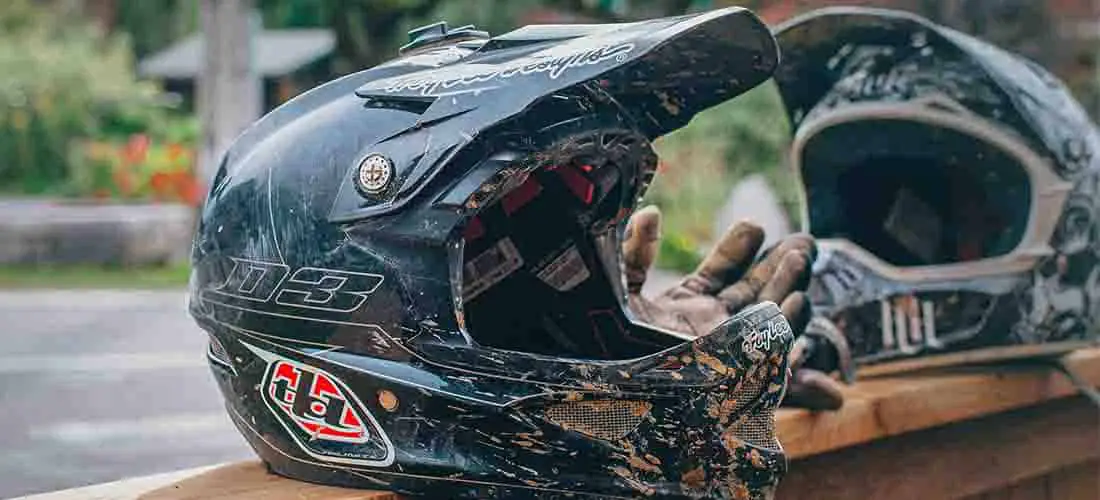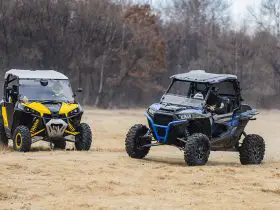You need to wear a helmet when riding side by side vehicles. Not wearing a helmet can result in serious injuries and fines. Your helmet also have to be CSA-compliant. Same regulations that are applicable for motorcycle helmets, applys to UTVs.
Lots of people get injured every year while riding side-by-side UTVs. According to the authorities, many of those accidents involve fatal injuries to the head and results in traumatic conditions. These are the riders who aren’t wearing helmets while driving through rough terrains.
Off-roading recreational sports has its own laws and regulations. They are designed to keep the riders safe and minimize the negative impacts it may have on the society and environment. Although the same rule applies through all the states, there may be some variations on the local and county levels.
On the 15th of May 2017, CSA-compliant helmets should be worn by riders while driving side-by-side UTVs on public land. Because helmets are the most important piece of safety gear, people riding any kind of UTVs must wear them.
Continue reading the article to find more about UTV helmet laws and certain considerations a rider should have to stay safe.
Table of Contents
Why do you need to wear a helmet while off-roading?
Indeed it is tempting and quite easy to fall into the trap and hop on to your off-road vehicle without a helmet. But, the move could be a risky one, and very fatal for your head in case you are met with an accident. To prevent head injury, wearing a helmet is a must whenever you go on for a ride.
A helmet helps you protect your head from dirt, gravel, and other kinds of materials that flung up in the air by the vehicle’s tires either from yours or from a passer-by. Also, helmets help to lessen the impact of a falling branch when you are rock-crawling.
Helmets that help cover up your face protect your mouth, nose, and chin from a sudden impact with the steering wheel or side handlebars in a serious abrupt stop. Last but not the least, a helmet serves as an important protection for your head in situations where the vehicle tips over.
The result of the impact on your head remains the same if by any chance you get tossed up from the vehicle. Keep in mind that such accidents can happen anytime at any place, and it won’t matter how much experience you possess as a rider.
Apart from their safety features, helmets help to lower down noises and wind when you are riding your UTV. Depending on the pattern and color, helmets can add styling to your ride. Also, helmets make you more visible to the fellow off-roaders.
So, do you need to wear helmets when riding a side-by-side?
It is crucial to note that even though a UTVs construction is pretty much different from other forms of all-terrain vehicles (ATVs and dirt bikes), with improved doors, harnesses or seatbelts and roll-over protection, a side-by-side rider has to wear a helmet always.
Whatever the design your UTV may have, there are chances that you can be struck by flying debris, trailside or overhanging tree branches, or serious head injury in an event of a rollover or crash. Always wear a helmet every time you go out for a ride regardless of thinking that the adventure won’t be an intense one.
When do you need helmets?
Helmets are necessary for anyone operating, driving, riding, or being towed by other UTVs. Any kind of motorized vehicle that is made for cross-country travel including the all-terrain vehicles like UTVs or side-by-side will require a helmet while driving.
Want to know about UTV safety tips? Then you might like our article 10 Tips on UTV Safety.
What is the penalty or fine for not wearing helmets?
Like all other kinds of recreation, off-roading has its share of laws and regulations. These rules are made to safeguard the common interest of society and to keep people safe. And, not following any kind of specific order may attract fines or penalties.
The same thing happens with drivers who aren’t wearing helmets while riding their side-by-sides. The fine for not wearing a helmet is $155, and the fine for not wearing a CSA-compliant helmet is about $93. Now, that’s the same penalty a riding might have to incur while riding a bike without a helmet.
CSA-compliant helmets:
Side-by-side helmets have to follow the same regulations that are applicable for motorcycle helmets. Here are the standards:
- CAN3-D230-M85 CSA Standard, protective headgear in a motor vehicle
- Standard Number 218, motorcycle helmets as stated under the Code of Federal Regulations Part 571.218, United States
- Standard BS6658:1985 of the British Standards Institution, specifications for specialized helmets intended for vehicle users
- SMF (Snell Memorial Foundation) 2000/2005/2010 Standard for protective headgear made to use with motorcycles, bikes, or other kinds of motorized vehicles
- The UNs Economic Commission for European Regulation 22-05, provisions that concern about the approval of using protective helmets along with their visors for passengers and drivers of motorcycles
Consideration and safety regulations:
It is very important to have a thorough understanding of the specific off-road vehicle regulations in an area where you would be riding. UTV helmet laws and other laws for ATVs and UTVs vary from one state to another. However, all the states do follow a major portion of the rules.
Whatever the rules are, it is wise to wear a helmet whenever you are planning to have a ride. This way, you can avoid any kind of penalties not for wearing your headgear and protect your head from injuries if you met with an accident. It is always better to spend a few extra bucks buying the best quality riding helmet.
There are lots of products needed in daily life and you can save money by purchasing those things in lesser quality. But, helmets for your UTV or ATV should be of the highest quality. Buying quality helmets saves you from unwanted fines and protect your head from severe injuries.
It is really worth paying for a well-designed and high-quality protective headgear. It is better to buy a new helmet rather than picking up an old one. Buying a secondhand headgear can save you money, but you can’t know whether the helmet has gone through a rough phase at some point.
Focus on buying a Helmet that has the stamp of the Department of Transportation (DoT) US safety standard. The SNELL rating is another certification widely used and it is even more stringent. It was named after a racecar driver Pete Snell, who succumbed to death from head injuries in a crash.
Also, you may find riding helmets with an ECE (Economic Commission for Europe) safety rating. Certain kinds of helmets do come with many ratings. Having multiple ratings on helmets is better. Always find the best helmet because it protects your head and helps to avoid unnecessary penalties.
When do you know it’s time for a replacement?
You need to replace a product when it gets older and sustained enough damage. When you feel that your helmet has undergone a major impact while you are off-roading, perhaps it is time for you to replace it with a new one.
If you can’t see visible signs of strains on your helmet, chances are they may have sustained damage to the inner lining or other portion of its structure. And, remember that it is always better to remain safe than sorry.
The helmet has protected your head from an accident and its sole purpose has been fulfilled. Now, it’s time to replace the old helmet with a new one.
How to choose your helmet:
Keeping in view of the existing rules and regulations of the states and your personal preference, choosing the right helmet for your specific needs is a bit challenging one. The helmet depends on your off-road trips with a focus on your safety first.
Apart from the different types of helmets discussed below, you need to consider its weight. A helmet that is quite heavy can put extra strain on your delicate neck after a tiring day of intense riding.
Besides the common design considerations, there are certain features a helmet should have. This may include air vents, dust masks, removable mouthpieces, and camera mounts for an easy recording while riding for off-road adventuring.
Open face helmets
These kinds of helmets lack the molding of your mouth and chin, unlike the full-face helmets. Open face helmets are traditional or classic ones. These kinds of helmets provide you least protection because it doesn’t cover your face area.
They can protect your head from direct impacts. Open face helmets are not suitable for off-road vehicles and aren’t recommended.
Full face helmets
The best kind of helmet for an ATV or UTV is a full-face helmet. It extends out in the front portion of your mouth and chin. It provides strong head protection compared to the open face helmets.
If there is a crash, your face won’t be affected by the impacts and scrapes. These helmets have a visor to keep away dust and wind from your face. Although they protect the whole face, a full-face helmet is quite rigid than the motocross helmets.
Motocross helmets
Originally designed for off-road racing, the motocross helmets are a sub-variety of the full face ones and make the perfect choice for UTV side-by-side riders. The helmet incorporates robust chin bars along with face visors or shields to provide comprehensive protection to your head.
Because the helmet covers almost every part of your face, they are built with special materials for maximum impact dissipating abilities. Also, they provide a good ventilation system to keep you cool and fresh during your ride.
What are the helmet requirements for a UTV?
Each year there has been a rise in UTV or ATV accidents where someone involved was not wearing a helmet. On rare occasions, some of the victims may have survived if they were wearing perfect headgear. It seems that a helmet is an important piece of equipment you can buy.
DOT-approved helmets are a must to ride on ATVs or UTVs, and both drivers and passengers need to wear them. Although there is no law that lays emphasis on protecting your eyes, it is recommended that drivers and passengers need to wear safety glasses, goggles, or face shield attached to the approved helmet.
Motocross helmets are specifically designed to use on off-road vehicles, and these are the best choice for people riding side-by-side. Also, they have the perfect structural design that complies with the state guidelines about wearing a helmet with safety glasses and protection for your chin.
How to wear your helmet to make it fit
You have to invest some time in finding out that the helmet you are wearing for your ride properly fits on your head. If the helmet isn’t fitted nicely, it won’t be able to deliver maximum protection when you are out in the wild. It is very crucial that you fit the helmet well in your head.
The helmet should fit comfortably on your head. Make sure that it doesn’t shift when you move your head up and down, or sideways. You can’t squeeze your finger between your forehead and helmet without trouble. And, twitching the helmet won’t twitch your cheeks while you try with your hands.
There isn’t any kind of fitting issues with these riding helmets as seen in other apparel. The important thing is that the helmet has to fit properly. While buying, try to zero in some sizes for that perfect fit. Keep in mind that the helmet has to fit in snugly without trouble.
Rules for off-road driving
Both local and state laws for ATVs, UTVs, or side-by-sides speaks about vehicle registration, maintaining proper speed limits, prohibited and open trials, restricted areas, and other rules. Depending on the size of the off-road vehicle, there could be age requirements associated.
Four-wheeler riders need to wear helmets and it is very important for their safety. Wear a helmet properly and make sure it is fitted nicely. Most importantly, insurance is necessary to go on rides in UTVs. Know more about how insurance works on UTVs in our article here.
Understanding the rules and regulations of riding a UTV side by side in any location ensures that you are safe and sound. Following the helmet laws in that specific area helps your stay protected from severe head injuries.
Sources
https://www.alberta.ca/off-highway-vehicle-helmet-law.aspx
https://www.offroad-ed.com/wisconsin/studyGuide/Meeting-ATV%7cUTV-Helmet-Requirements/40105102_700127725/
https://www.northernontario.travel/atving/side-by-side-and-atv-laws-rules-and-regulations-for-off-road-and-street-legal-riding
https://www.albertapowersports.com/new-helmet-laws/
https://utvactionmag.com/buyers-guide-lowdown-upside-utv-helmets/
https://offroad.polaris.com/en-us/articles/sxs-utv-atv-helmets/










